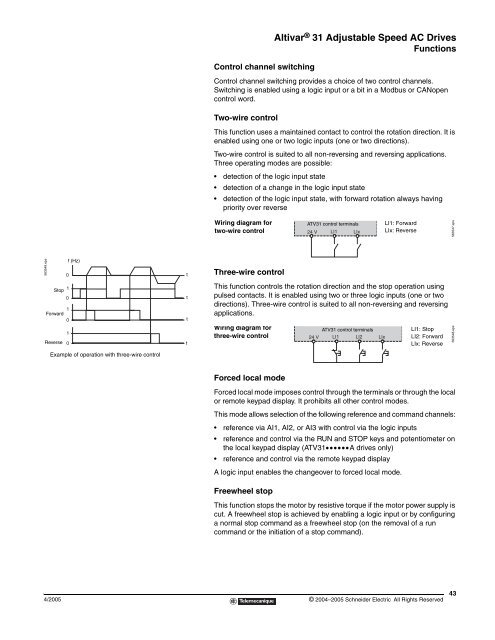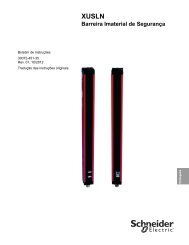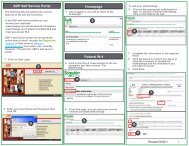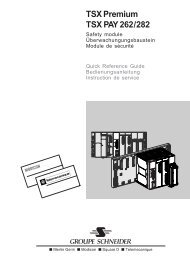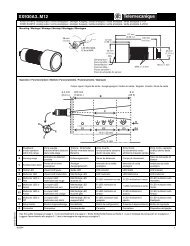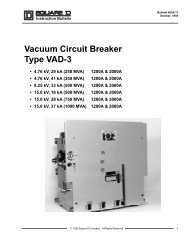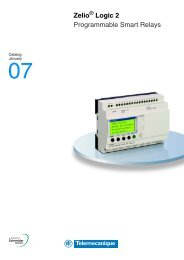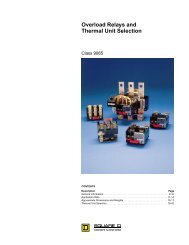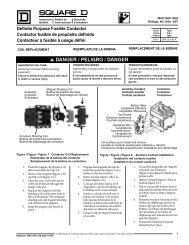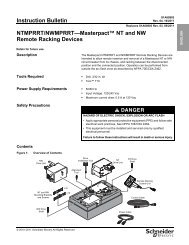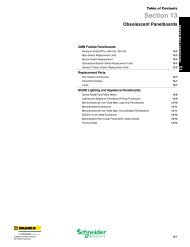Altivar 31 - Square D
Altivar 31 - Square D
Altivar 31 - Square D
Create successful ePaper yourself
Turn your PDF publications into a flip-book with our unique Google optimized e-Paper software.
563549.eps<br />
Stop<br />
1<br />
1<br />
Forward<br />
0<br />
Reverse<br />
0<br />
0<br />
1<br />
0<br />
f (Hz)<br />
Example of operation with three-wire control<br />
t<br />
t<br />
t<br />
t<br />
Control channel switching<br />
<strong>Altivar</strong> ® <strong>31</strong> Adjustable Speed AC Drives<br />
Functions<br />
Control channel switching provides a choice of two control channels.<br />
Switching is enabled using a logic input or a bit in a Modbus or CANopen<br />
control word.<br />
Two-wire control<br />
This function uses a maintained contact to control the rotation direction. It is<br />
enabled using one or two logic inputs (one or two directions).<br />
Two-wire control is suited to all non-reversing and reversing applications.<br />
Three operating modes are possible:<br />
detection of the logic input state<br />
detection of a change in the logic input state<br />
detection of the logic input state, with forward rotation always having<br />
priority over reverse<br />
Wiring diagram for<br />
two-wire control<br />
Three-wire control<br />
This function controls the rotation direction and the stop operation using<br />
pulsed contacts. It is enabled using two or three logic inputs (one or two<br />
directions). Three-wire control is suited to all non-reversing and reversing<br />
applications.<br />
Wiring diagram for<br />
three-wire control<br />
Forced local mode<br />
Forced local mode imposes control through the terminals or through the local<br />
or remote keypad display. It prohibits all other control modes.<br />
This mode allows selection of the following reference and command channels:<br />
reference via AI1, AI2, or AI3 with control via the logic inputs<br />
reference and control via the RUN and STOP keys and potentiometer on<br />
the local keypad display (ATV<strong>31</strong>••••••A drives only)<br />
reference and control via the remote keypad display<br />
A logic input enables the changeover to forced local mode.<br />
Freewheel stop<br />
ATV<strong>31</strong> control terminals<br />
24 V LI1 LIx<br />
LI1: Forward<br />
LIx: Reverse<br />
ATV<strong>31</strong> control terminals LI1: Stop<br />
24 V LI1 LI2 LIx LI2: Forward<br />
LIx: Reverse<br />
This function stops the motor by resistive torque if the motor power supply is<br />
cut. A freewheel stop is achieved by enabling a logic input or by configuring<br />
a normal stop command as a freewheel stop (on the removal of a run<br />
command or the initiation of a stop command).<br />
4/2005 © 2004–2005 Schneider Electric All Rights Reserved<br />
563547.eps<br />
563548.eps<br />
43


